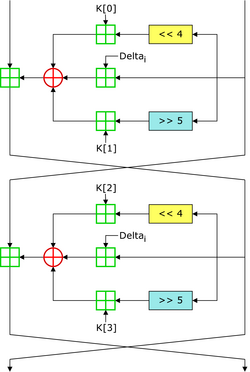Related Research Articles

The Data Encryption Standard is a symmetric-key algorithm for the encryption of digital data. Although its short key length of 56 bits makes it too insecure for modern applications, it has been highly influential in the advancement of cryptography.

In cryptography, the International Data Encryption Algorithm (IDEA), originally called Improved Proposed Encryption Standard (IPES), is a symmetric-key block cipher designed by James Massey of ETH Zurich and Xuejia Lai and was first described in 1991. The algorithm was intended as a replacement for the Data Encryption Standard (DES). IDEA is a minor revision of an earlier cipher Proposed Encryption Standard (PES).
In cryptography, RC4 is a stream cipher. While it is remarkable for its simplicity and speed in software, multiple vulnerabilities have been discovered in RC4, rendering it insecure. It is especially vulnerable when the beginning of the output keystream is not discarded, or when nonrandom or related keys are used. Particularly problematic uses of RC4 have led to very insecure protocols such as WEP.

In cryptography, the Tiny Encryption Algorithm (TEA) is a block cipher notable for its simplicity of description and implementation, typically a few lines of code. It was designed by David Wheeler and Roger Needham of the Cambridge Computer Laboratory; it was first presented at the Fast Software Encryption workshop in Leuven in 1994, and first published in the proceedings of that workshop.

In cryptography, XTEA is a block cipher designed to correct weaknesses in TEA. The cipher's designers were David Wheeler and Roger Needham of the Cambridge Computer Laboratory, and the algorithm was presented in an unpublished technical report in 1997. It is not subject to any patents.

David John Wheeler FRS was a computer scientist and professor of computer science at the University of Cambridge.

In cryptography, RC2 is a symmetric-key block cipher designed by Ron Rivest in 1987. "RC" stands for "Ron's Code" or "Rivest Cipher"; other ciphers designed by Rivest include RC4, RC5, and RC6.
In cryptography, the eXtended Sparse Linearization (XSL) attack is a method of cryptanalysis for block ciphers. The attack was first published in 2002 by researchers Nicolas Courtois and Josef Pieprzyk. It has caused some controversy as it was claimed to have the potential to break the Advanced Encryption Standard (AES) cipher, also known as Rijndael, faster than an exhaustive search. Since AES is already widely used in commerce and government for the transmission of secret information, finding a technique that can shorten the amount of time it takes to retrieve the secret message without having the key could have wide implications.
Bart Preneel is a Belgian cryptographer and cryptanalyst. He is a professor at Katholieke Universiteit Leuven, in the COSIC group.
Nicolas Tadeusz Courtois is a cryptographer and senior lecturer in computer science at University College London.

Serge Vaudenay is a French cryptographer and professor, director of the Communications Systems Section at the École Polytechnique Fédérale de Lausanne
In cryptography, Galois/Counter Mode (GCM) is a mode of operation for symmetric-key cryptographic block ciphers which is widely adopted for its performance. GCM throughput rates for state-of-the-art, high-speed communication channels can be achieved with inexpensive hardware resources.
In cryptography, Achterbahn is the name of a synchronous stream cipher algorithm submitted to the eSTREAM Project of the eCRYPT network. In the final specification the cipher is called ACHTERBAHN-128/80, because it supports the key lengths of 80 bits and 128 bits, respectively. Achterbahn was developed by Berndt Gammel, Rainer Göttfert and Oliver Kniffler. Achterbahn means rollercoaster, though a literal translation of the term would be eight-track, which indicates that the cipher can encrypt eight bit streams in parallel.
In cryptography, Hierocrypt-L1 and Hierocrypt-3 are block ciphers created by Toshiba in 2000. They were submitted to the NESSIE project, but were not selected. Both algorithms were among the cryptographic techniques recommended for Japanese government use by CRYPTREC in 2003, however, both have been dropped to "candidate" by CRYPTREC revision in 2013.
In cryptography, a T-function is a bijective mapping that updates every bit of the state in a way that can be described as , or in simple words an update function in which each bit of the state is updated by a linear combination of the same bit and a function of a subset of its less significant bits. If every single less significant bit is included in the update of every bit in the state, such a T-function is called triangular. Thanks to their bijectivity regardless of the used Boolean functions and regardless of the selection of inputs, T-functions are now widely used in cryptography to construct block ciphers, stream ciphers, PRNGs and hash functions. T-functions were first proposed in 2002 by A. Klimov and A. Shamir in their paper "A New Class of Invertible Mappings". Ciphers such as TSC-1, TSC-3, TSC-4, ABC, Mir-1 and VEST are built with different types of T-functions.
In cryptography, Zodiac is a block cipher designed in 2000 by Chang-Hyi Lee for the Korean firm SoftForum.
In cryptography, an alternating step generator (ASG) is a cryptographic pseudorandom number generator used in stream ciphers, based on three linear-feedback shift registers. Its output is a combination of two LFSRs which are stepped (clocked) in an alternating fashion, depending on the output of a third LFSR.
This article summarizes publicly known attacks against block ciphers and stream ciphers. Note that there are perhaps attacks that are not publicly known, and not all entries may be up to date.
Anne Canteaut is a French researcher in cryptography, working at the French Institute for Research in Computer Science and Automation (INRIA) in Paris. She studies the design and cryptanalysis of symmetric-key algorithms and S-boxes.

Orr Dunkelman is an Israeli cryptographer and cryptanalyst, currently a professor at the University of Haifa Computer Science department. Dunkelman is a co-director of the Center for Cyber Law & Privacy at the University of Haifa and a co-founder of Privacy Israel, an Israeli NGO for promoting privacy in Israel.
References
- Blöcher, Uwe; Dichtl, Markus (1994), "Fish: A fast software stream cipher", Fast Software Encryption, Lecture Notes in Computer Science, vol. 809, Springer-Verlag, pp. 41–44, doi: 10.1007/3-540-58108-1_4 , ISBN 978-3-540-58108-6 .
- Anderson, Ross J. (1995), "On Fibonacci keystream generators", Fast Software Encryption, Lecture Notes in Computer Science, vol. 1008, Springer-Verlag, pp. 346–352, doi: 10.1007/3-540-60590-8_26 , ISBN 978-3-540-60590-4 .